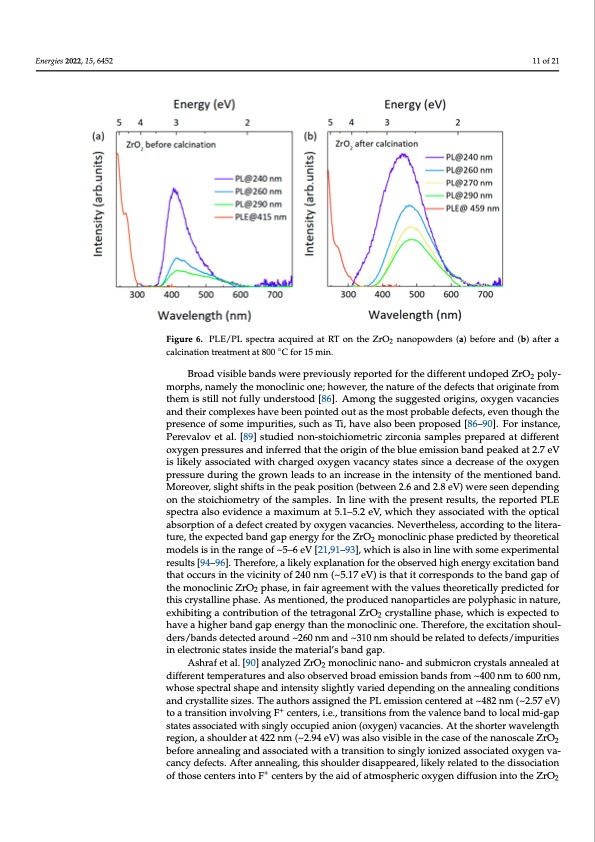
PDF Publication Title:
Text from PDF Page: 011
Energies 2022, 15, 6452 the PL maximum shifted to longer wavelengths, around ~475 nm (~2.61 eV). Indeed, the band observed at ~459 nm is likely to be composed of several recombination channels, including the ones which are preferentially excited with photons with wavelengths in the 260–290 nm range. The PLE monitored at the maximum of the observed PL bands revealed, in both cases, an excitation band at ~310 nm (~4.00 eV), a noticed shoulder at 11 of 21 ~260 nm (~4.77 eV) and an excitation band maximum at ~240 nm (~5.17 eV), indicating that those are the preferential population paths for the observation of such emission. Figure 6. PLE/PL spectra acquired at RT on the ZrO2 nanopowders (a) before and (b) after a Figure 6. PLE/PL spectra acquired at RT on the ZrO2 nanopowders (a) before and (b) after a calcination treatment at 800 °C for 15 min. calcination treatment at 800 ◦C for 15 min. Broad visible bands were previously reported for the different undoped ZrO2 Broad visible bands were previously reported for the different undoped ZrO2 poly- polymorphs, namely the monoclinic one; however, the nature of the defects that originate morphs, namely the monoclinic one; however, the nature of the defects that originate from them is still not fully understood [86]. Among the suggested origins, oxygen vacancies and their complexes have been pointed out as the most probable defects, even though the presence of some impurities, such as Ti, have also been proposed [86–90]. For instance, Perevalov et al. [89] studied non-stoichiometric zirconia samples prepared at different oxygen pressures and inferred that the origin of the blue emission band peaked at 2.7 eV is likely associated with charged oxygen vacancy states since a decrease of the oxygen pressure during the grown leads to an increase in the intensity of the mentioned band. Moreover, slight shifts in the peak position (between 2.6 and 2.8 eV) were seen depending on the stoichiometry of the samples. In line with the present results, the reported PLE spectra also evidence a maximum at 5.1–5.2 eV, which they associated with the optical absorption of a defect created by oxygen vacancies. Nevertheless, according to the litera- ture, the expected band gap energy for the ZrO2 monoclinic phase predicted by theoretical models is in the range of ~5–6 eV [21,91–93], which is also in line with some experimental results [94–96]. Therefore, a likely explanation for the observed high energy excitation band that occurs in the vicinity of 240 nm (~5.17 eV) is that it corresponds to the band gap of the monoclinic ZrO2 phase, in fair agreement with the values theoretically predicted for this crystalline phase. As mentioned, the produced nanoparticles are polyphasic in nature, exhibiting a contribution of the tetragonal ZrO2 crystalline phase, which is expected to have a higher band gap energy than the monoclinic one. Therefore, the excitation shoul- ders/bands detected around ~260 nm and ~310 nm should be related to defects/impurities in electronic states inside the material’s band gap. Ashraf et al. [90] analyzed ZrO2 monoclinic nano- and submicron crystals annealed at different temperatures and also observed broad emission bands from ~400 nm to 600 nm, whose spectral shape and intensity slightly varied depending on the annealing conditions and crystallite sizes. The authors assigned the PL emission centered at ~482 nm (~2.57 eV) to a transition involving F+ centers, i.e., transitions from the valence band to local mid-gap states associated with singly occupied anion (oxygen) vacancies. At the shorter wavelength region, a shoulder at 422 nm (~2.94 eV) was also visible in the case of the nanoscale ZrO2 before annealing and associated with a transition to singly ionized associated oxygen va- cancy defects. After annealing, this shoulder disappeared, likely related to the dissociation of those centers into F+ centers by the aid of atmospheric oxygen diffusion into the ZrO2PDF Image | Comparison between Solution-Based Synthesis Methods of ZrO2

PDF Search Title:
Comparison between Solution-Based Synthesis Methods of ZrO2Original File Name Searched:
energies-15-06452.pdfDIY PDF Search: Google It | Yahoo | Bing
Turbine and System Plans CAD CAM: Special for this month, any plans are $10,000 for complete Cad/Cam blueprints. License is for one build. Try before you buy a production license. More Info
Waste Heat Power Technology: Organic Rankine Cycle uses waste heat to make electricity, shaft horsepower and cooling. More Info
All Turbine and System Products: Infinity Turbine ORD systems, turbine generator sets, build plans and more to use your waste heat from 30C to 100C. More Info
CO2 Phase Change Demonstrator: CO2 goes supercritical at 30 C. This is a experimental platform which you can use to demonstrate phase change with low heat. Includes integration area for small CO2 turbine, static generator, and more. This can also be used for a GTL Gas to Liquids experimental platform. More Info
Introducing the Infinity Turbine Products Infinity Turbine develops and builds systems for making power from waste heat. It also is working on innovative strategies for storing, making, and deploying energy. More Info
Need Strategy? Use our Consulting and analyst services Infinity Turbine LLC is pleased to announce its consulting and analyst services. We have worked in the renewable energy industry as a researcher, developing sales and markets, along with may inventions and innovations. More Info
Made in USA with Global Energy Millennial Web Engine These pages were made with the Global Energy Web PDF Engine using Filemaker (Claris) software.
Sand Battery Sand and Paraffin for TES Thermo Energy Storage More Info
| CONTACT TEL: 608-238-6001 Email: greg@infinityturbine.com | RSS | AMP |